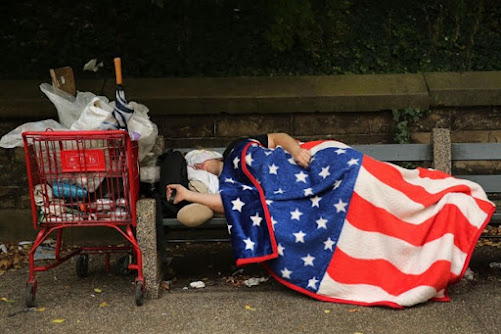This pivotal moment demands that state Departments of Social Services and USICH fundamentally transform their approach, moving from a narrow focus on immediate shelter to a comprehensive strategy that addresses the core issues driving homelessness.
In 2023, the United States witnessed an alarming surge in homelessness, setting a distressing record for the largest increase since the federal government began collecting such data in 2007. This unprecedented rise brought the number of Americans living in shelters and on the streets to an all-time high. States like New York have been particularly impacted, with New York City Mayor Eric Adams declaring the city's shelters at full capacity, largely due to soaring illegal immigration. This situation is a stark indicator of a deep-rooted issue that is neither new nor confined to any single area, but a national crisis.
For
over two decades, the federal government's primary approach to homelessness has
been the "Housing First" strategy. This policy provides permanent
supportive housing without any preconditions, such as sobriety or engagement in
treatment programs. The theory behind this approach is that securing housing is
the first and most crucial step in resolving homelessness. However, this
strategy has proven to be ineffective in several key aspects.
Despite
its intention, "Housing First" has not significantly reduced the
overall rates of homelessness. For instance, California saw a 50% increase in
its unsheltered homeless population between 2010 and 2019, despite adding
25,000 permanent supportive housing units. Furthermore, the costs associated
with this approach are staggering, as evidenced by a Los Angeles project that
spent approximately $690,000 per housing unit.
In
contrast, "treatment-first" models have shown greater success in
improving the lives of homeless individuals. Programs like the Birmingham Model
exemplify this approach, skillfully intertwining housing provision with
obligatory treatment and support services. This model specifically targets
underlying challenges such as substance abuse, recognizing that housing alone
is not a panacea for the complexities of homelessness. By integrating personal
development and recovery programs into the housing process, these models
promote not just temporary shelter but sustainable, long-term well-being. This
method not only benefits the individuals by fostering personal growth and
independence but also optimizes the use of resources, reducing the cycle of
dependency on government-funded housing solutions.
Another
critical dimension in addressing homelessness is the focus on mental health. A
considerable segment of the homeless population battles severe mental health
issues, a fact that underscores the urgent need for more comprehensive mental
health care services. Enhanced mental health care systems, including an
increased availability of hospital beds for those with severe mental illness,
are essential. Moreover, the implementation of preventive strategies plays a
pivotal role. Initiatives like short-term rental assistance and employment
support programs can be instrumental in preventing individuals from slipping
into homelessness. These proactive measures not only address the immediate
needs of at-risk individuals but also contribute to a broader strategy of
homelessness prevention, targeting potential causes before they escalate into
crises.
At
the local level, the collaboration between government bodies and nonprofit
organizations is vital in providing immediate relief and support to those in
need. Local governments have a crucial role in ensuring the availability of
emergency and short-term shelters, offering a safe haven for individuals and
families in crisis. Additionally, it's imperative for cities to maintain public
order and safety. Enforcing laws against illegal activities and unauthorized
encampments is not just about upholding legal statutes; it's about preserving
the dignity and safety of public spaces for all citizens. This approach helps
create a balanced and humane environment, where the needs of the homeless are addressed
with compassion and effectiveness, while also maintaining the quality and
safety of public spaces for the broader community.
For
state Departments of Social Services and the United States Interagency Council
on Homelessness (USICH), the current homelessness crisis signals a critical
juncture that calls for a comprehensive reassessment of their strategies and
policies. This situation demands a shift from traditional methods that
primarily focus on providing immediate shelter to a more holistic approach that
addresses the root causes of homelessness. State agencies and USICH are now
faced with the challenge of integrating services that promote overall wellness,
mental health, sobriety, and employment stability into their programs. This
change in strategy means these organizations must broaden their scope of
services and collaborations, possibly involving a more diverse range of stakeholders,
including healthcare providers, job training centers, and substance abuse
treatment facilities. The emphasis should be on creating long-term, sustainable
solutions that empower homeless individuals to achieve self-sufficiency and
maintain their dignity.
The
implication of this shift for these agencies is profound. They must adapt to a
more dynamic, multi-faceted operational model that goes beyond the traditional
provisioning of housing. It involves re-allocating resources, developing new
programs, and possibly advocating for legislative changes that support these
holistic initiatives. For USICH, this could mean playing a more active role in
coordinating efforts across different levels of government and private
organizations, ensuring a cohesive and unified approach to homelessness. It
also means evaluating current funding models and exploring new sources of
funding that can support these expanded services. Ultimately, this paradigm
shift is not just about altering services; it is about transforming the way
these organizations perceive and address homelessness, moving from a
short-term, reactive stance to a long-term, proactive one that seeks to restore
dignity and stability in the lives of those they serve.





No comments:
Post a Comment